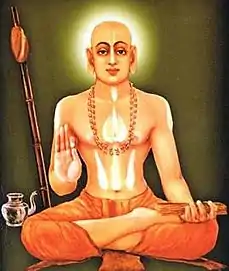Satyavijaya Tirtha
Shri Satyavijaya Tirtha (died 1737) (Śrī Satya-vijaya Tīrtha) was an Indian Hindu philosopher, guru, and scholar. He was the successor of Satyapurna Tirtha and the 23rd pontiff of Uttaradi Math since Madhvacharya, the chief proponent and the one who rejuvenated this Dvaita philosophy and served the pontificate from 1726–1737.[2][3][4][5]
Sri Satyavijaya Tirtha | |
|---|---|
| Personal | |
| Born | Pandurangi Balacharya |
| Died | 1737 |
| Religion | Hinduism |
| Order | Vedanta (Uttaradi Math) |
| Philosophy | Dvaita, Vaishnavism |
| Religious career | |
| Guru | Satyapurna Tirtha |
| Predecessor | Satyapurna Tirtha |
| Successor | Satyapriya Tirtha |
Disciples
| |
| Part of a series on |
| Dvaita |
|---|
 |
| Hinduism portal |
Biography
According to hagiographies,Satyavijaya Tirtha was born Pandurangi Balacharya in a prominent family of scholars to Pandurangi Srinivasacharya. Satyavijaya Tirtha was given sanyasa by Satyapurna Tirtha with specific instructions that he, in turn, should hand over the Samsthana to his asrama senior Satyapriya Tirtha. Since Satyavijaya Tirtha was older in age he was given opportunity to be the Pontiff of Uttaradi Math after Satyapurna Tirtha.[6] Satyavijaya Tirtha served as the pontiff of Uttaradi Math from 1726 - 1737. During this time according to manuscripts which dates to 1726 A.D Satyavijaya Tirtha was honoured in Varadharaja Perumal Temple, Kanchipuram with certain privileges.[7] In 1737 he handed over the pontificate to Satyapriya Tirtha. He died in 1737 and his mortal remains are enshrined in a mutt in Sathiyavijayanagaram (Arani) on the banks of river Kaveri.[8]
Legacy
- The village where his Brindavana (tomb) is located is name after him as Satya Vijaya Nagaram in Tamil Nadu.[9]
References
- Sharma 2000, p. 534.
- Dasgupta (1949). A History of Indian Philosophy: Volume 4. Cambridge University Press. p. 56. ISBN 978-0521047814.
- Manu V. Devadevan (10 October 2016). A Prehistory of Hinduism. Walter de Gruyter GmbH & Co KG. p. 60. ISBN 978-3110517378. Retrieved 10 October 2016.
- Surendranath Dasgupta (1975). A History of Indian Philosophy, Volume 4. Motilal Banarsidass. p. 56. ISBN 978-8120804159.
- Chinya V. Ravishankar (1 September 2018). Sons of Sarasvati: Late Exemplars of the Indian Intellectual Tradition. Global Academic Publishing. p. 212. ISBN 978-1438471853.
- K.T.Pandurangi (2000). Vyāsatīrtha viracitā Tātparyacandrikā: Jayatīrthaviracita Tattvaprakāśikāyāḥ vyākhyānarūpā : Rāghavendra Tīrthaviracitā Prakāśikayā, Pāṇḍuraṅgi Keśavācāryaviracita Bhāvadīpikayā ca sahitā, Volume 3. Dvaita Vedanta Studies and Research Foundation. p. lxiv.
- K.V. Raman (2003). Sri Varadarajaswami Temple, Kanchi: A Study of Its History, Art and Architecture. Abhinav Publications. p. 137. ISBN 978-8170170266.
- Naqvī & Rao 2005, p. 780.
- C. D. Maclean (1982). Glossary of the Madras Presidency: containing a classification of terminology, a gazetteer, and economic dictionary of the province, and other information, the whole arranged alphabetically and indexed. Asian Educational Service. p. 797.
Bibliography
- Sharma, B. N. Krishnamurti (2000). A History of the Dvaita School of Vedānta and Its Literature, Vol 1. 3rd Edition. Motilal Banarsidass (2008 Reprint). ISBN 978-8120815759.CS1 maint: ref=harv (link)
- Naqvī, Ṣādiq; Rao, V. Kishan (2005). A Thousand Laurels--Dr. Sadiq Naqvi: Studies on Medieval India with Special Reference to Deccan, Volume 2. Department of Ancient Indian History, Culture & Archaeology, Osmania University.CS1 maint: ref=harv (link)